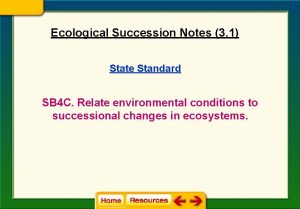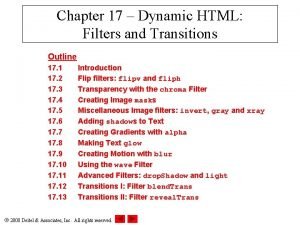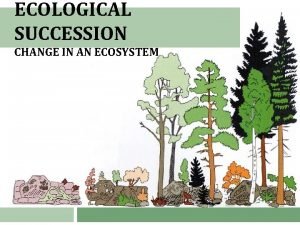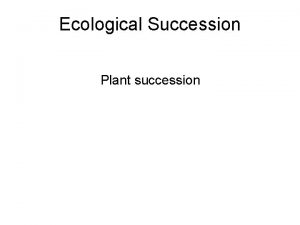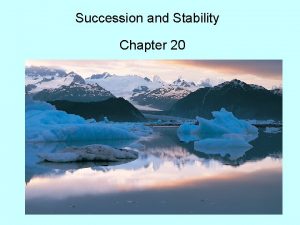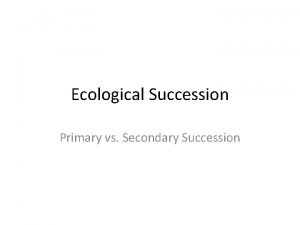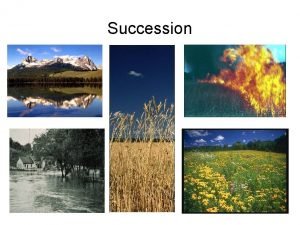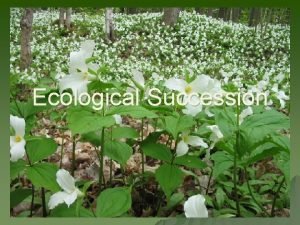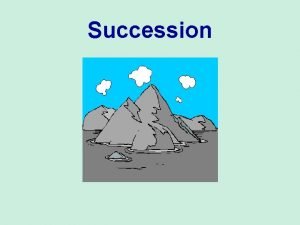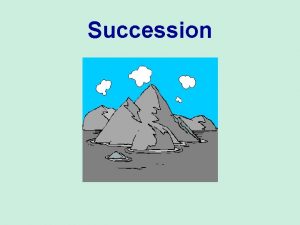States and Transitions in Succession Plant Community Succession














- Slides: 14

States and Transitions in Succession

Plant Community Succession (Initial Ideas – F. E. Clements) Natural Potential Climax or Potential Natural Community Large Variation Between Years Pioneer/Early Seral Stage Late

Plant Community Succession (Initial Ideas -- Clements) ive s s gre Pro ession infall c ra Suc rage Climax or Potential Natural Community ve ea bov Natural Potential A al ion s s ce Suc ency tend ss e r g o Retr ion ht ug Dro ure s s e g Pr zin Gra Pioneer/Early Seral Stage Late

Example -Succession in the western juniper woodland Grassland after fire Open young juniper Mountain big sagebrush steppe Young multistory juniper Stand initiation juniper Old multistory juniper

Cyclic Patterns creating a “Dynamic Equilibrium” 1979 - Pre-burn 1980 - 1 st year after fire 1994 1983 1989

Problems with Succession Model • multiple pathways of succession • multiple stable vegetation types • no single and certain end-point Two examples of stable states for same ecological site Wyoming big sagebrush/bluebunch wheatgrass steppe near Mtn. Home, ID Wyoming big sagebrush/bluebunch wheatgrass steppe, central Idaho

Problems with Succession Model • multiple pathways of succession • multiple stable vegetation types • no single and certain end-point State and Transition Models 1989 - Westoby, Walker and Noy-Meir

Focus on States of communities and Transitions between states State A State D State B State C

States and Transitions depend on biotic & abiotic conditions States are relatively stable but some states are more stable than others Creosotebush community -this ecological site may have always been creosotebush dominated, or degraded long ago.

States and Transitions depend on biotic & abiotic conditions Juniper Present Low Cheatgrass Risk Higher Elevation Southwestern Idaho Higher Elevation Central Idaho Cheatgrass Risk Lower Elevation Central Idaho States and stability depends on factors such as elevation & climate

Example - Sagebrush Steppe States Grassland Open Sagebrush Depleted Sagebrush Closed Sagebrush Transitions= compositional change resulting in the change in plant community (state) Fire transition Succession transition Improper grazing transition

Sagebrush Steppe State Grassland Open Sagebrush Depleted Sagebrush Closed Sagebrush Threshold Annual Grass Dominated State Grazing reduces likelihood of fire Thresholds = transitions that are nearly irreversible & sometimes unpredictable.

The information required to develop these models: • potential alternative vegetation states on a site • potential transitions between states • opportunities to achieve favorable transitions between vegetation states and hazards to avoid unfavorable transitions

Rangeland Ecology and Management Rangelands are Dynamic! • But, dynamic patterns can be describe in state and transition models. • We manage transitions
 Ecological succession succession of a pond
Ecological succession succession of a pond Ecological succession succession of a pond
Ecological succession succession of a pond Vertical blinds
Vertical blinds Transition words for thesis statement
Transition words for thesis statement Coordinators subordinators and transitions
Coordinators subordinators and transitions Progressive succession examples
Progressive succession examples Secondary successio
Secondary successio Tronsmo plant pathology and plant diseases download
Tronsmo plant pathology and plant diseases download Tronsmo plant pathology and plant diseases download
Tronsmo plant pathology and plant diseases download Albugo eye
Albugo eye Slave states free states
Slave states free states Map of northern united states
Map of northern united states Big states vs small states guard against tyranny
Big states vs small states guard against tyranny How to fade out audio in windows movie maker
How to fade out audio in windows movie maker Conclusion transitions
Conclusion transitions

